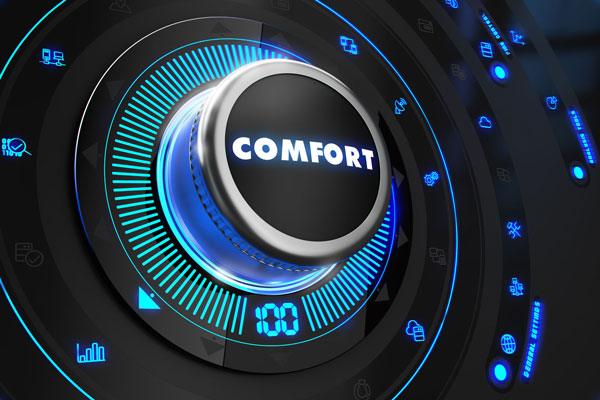
No matter the temperature outside, a facilities manager has to keep things comfortable inside. This prevents unhappy tenants, unusable buildings and repair budget overruns for problems like frozen pipes in winter.
A temperature control system can adjust the temperature inside a building. FMs can prepare for the changing seasons by acquainting themselves with this system in their own facility.
What Is a Temperature Control System?
As mentioned above, a temperature control system can alter how hot or cold a building is at any given time. While this seems easy enough, these systems can be decidedly more complicated. There are different components of a temperature control system that allow it to work optimally no matter the weather, says Jack Smith at Control Engineering. These are as follows:
- On-off control — The on-off control not only decides when the temperature control system will run, but at which temperature. This is done through what’s called a setpoint. Say it’s a chilly winter day, for example. An FM may want to keep the setpoint at about 65 degrees Fahrenheit. This prevents the building from getting too cold (without the FM necessarily having to be there) since temperatures won’t deviate far from that setpoint.
- Controller output — There are two parameters of closed-loop controller outputs according to Smith: proportion-integral-derivative or PID and proportional.
- PID — This parameter, as the name suggests, links derivative, integral and proportional variables together. “Integral action is also referred to as reset,” says Smith. “It is introduced when a stable process does not coincide with the setpoint. Derivative action is also referred to as rate. It is introduced when abrupt or rapid changes in the load effect controller response.”
- Proportional — Proportional controllers allow the FM to change temperature by time parameters, called time proportional controls. “If cycle time is adjustable, the time proportional control divides this cycle time into a percentage of that time,” Smith writes. “If the cycle time is 10 seconds, and the controller output is at 45 percent, the outputs are energized for 4.5 seconds of the cycle time.”
- Sensors — Sensors include both resistance temperature detectors or RTDs and thermocouples. The RTD uses electric signals, often through films and conductors, to match the desired temperature. The thermocouples pick up on the electrical readings from the RTD and generates matching mV voltage.

Types of Controllers
There are many types of temperature control systems, says process control and measurement company Omega. These include:
- Temperature switches — Using fewer electronic parts, temperature switches can be a good choice for FMs who need an “economical solution to temperature control.”
- Safety limit controllers — As the name suggests, safety limit controllers keep temperatures from reaching record highs or dangerous lows, which could threaten the building’s infrastructure.
- Multiloop controllers — Above, we discussed closed-loop control systems. Multiloop controllers are intended for more than one closed-loop control system, controlling as many as seven at once.
- Autotune PID controllers — We also talked about PID controllers before. This type uses autotuning to keep the PID algorithm in check.
Engineering product company Instrumart adds a few other types of temperature control systems to be aware of:
- Ramp-soak/profiling controllers — When using a ram-soak controller, it’s possible to add more than one temperature setpoint. “Programming a setpoint change is called ramp and the time to stay at each setpoint is called soak or dwell,” hence the name ramp-soak controller.
- Valve motor drive controllers — Valve motor drives, typically used for gas burners, can be opened or closed with this type of controller. “Special tuning algorithms give accurate control and fast output reaction without the need for slidewire feedback or excessive knowledge of three-term PID tuning algorithms,” says Instrumart.
- Analog controllers — Regarded as easy to operate, analog controllers are among the best in terms of beginner controllers. They’re also inexpensive. The FM can use dials and knobs to adjust the temperature.

Common Characteristics
Instrumart says most temperature control systems share common characteristics. These should be present no matter which controller an FM uses.
- Front panel enclosure rating — The National Electrical Manufacturers Association (NEMA) and the European Committee for Electrotechnical Standardization (CENELEC) are the two international parties that generally assign ratings to temperature control systems. NEMA ranks systems in Canada or the United States with a 4X or 4 for corrosion protection when used with water. CENELEC, using Ingress Protection (IP) numbers, will generally rank a good European (and sometimes North American) controller IP65.
- Agency approval — According to Barry Slotnick at HVAC company Thermal Edge Inc, all heating and cooling systems must be marked cUL or UL, with the former standing for the Canadian Underwriters Laboratories and the latter standing for just the Underwriters Laboratories. These approvals guarantee there are no problems with the temperature control system.
- Standard size — Regardless of the type, most controllers are about the same size. The German standard, Deutsche Institut fur Normung (DIN), measures and approves the size of control systems. This is the size range:
- ¼ DIN
- 1/8 DIN
- 1/16 DIN
- 1/32 DIN
- Supply voltage — We’ve talked briefly about voltage before and how it relates to the sensors in a temperature control system. With controllers, all voltages are either higher (about 110 to 230 VACs) or lower (24 VACs and up).

What Is the Future of Temperature Control Systems?
The technology that drives these temperature control systems is always evolving and improving. Mikell Knights at Plastics Machinery Magazine discusses new technology from the 2015 National Pavement Expo (NPE). That includes:
- Streamlined controllers — Above, we mentioned how controllers are measured using the DIN standard, from ¼ DIN to 1/32 DIN. Knights reports that some manufacturers are working on even smaller controllers that can still warm or cool a building.
- Dashboards for simpler control — High-tech controllers are taking the manual effort out of temperature control. These newer models come with a centralized dashboard so FMs can change heating, cooling and other controls right from their office or home.
- Heated or chilled water for energy efficiency — Other controllers Knights saw have their own water control unit so they can run heated or chilled water through the system. The water may be able to flow at rates of nearly 90 psi and 30 gallons per minute, reaching a peak temperature of about 400 degrees Fahrenheit.
These controllers were showcased over a year ago, so it’s likely FMs can find controllers with this technology today.
Credits:
123RF Stock PhotoSteve Richey
Kamal J
Deb Rousseau

